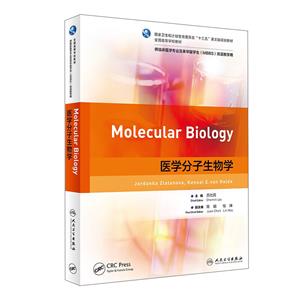-
>
中醫入門必背歌訣
-
>
醫驗集要
-
>
尋回中醫失落的元神2:象之篇
-
>
補遺雷公炮制便覽 (一函2冊)
-
>
人體解剖學常用詞圖解(精裝)
-
>
神醫華佗(奇方妙治)
-
>
(精)河南古代醫家經驗輯
醫學分子生物學(本科/雙語教材) 版權信息
- ISBN:9787117328104
- 條形碼:9787117328104 ; 978-7-117-32810-4
- 裝幀:一般膠版紙
- 冊數:暫無
- 重量:暫無
- 所屬分類:>>
醫學分子生物學(本科/雙語教材) 本書特色
本書是根據Garland Science出版的Molecular Biology改編。作者對每一章節的內容進行了修改,特別增加了第15章疾病基因、第16章基因診斷和治療,以滿足中國醫學生的需要。 分子生物學是在分子水平上研究生命現象、原理和本質的學科。分子生物學的定義是研究基因,一段DNA表達的功能產物,如RNA和蛋白質。此外,分子生物學的知識和技術已經融入到醫學的各個學科中,促進和發展了一個新的醫學分支,稱為分子醫學。分子醫學是指了解疾病的病因、發病機制、發展和預后,運用分子生物學對疾病進行診斷、治療和預防。因此,醫學生必須熟悉分子生物學不僅僅是為了閱讀論文,做實驗也是為了使用正確的分子診斷和治療方法。在中國醫學教育體系下,編寫適合中外學生培養的分子生物學課程和教材是基礎和必要的。
醫學分子生物學(本科/雙語教材) 內容簡介
根據教育部相關文件規定,為滿足醫學院校臨床醫學專業雙語教學和來華留學生教學的需要,在調研、論證的基礎上組織編寫本套教材。本教材為英文版規劃教材之一,在引進外版教材的基礎上,根據我國教學實際情況進行改編,以使知識體系和主要內容基本符合教學大綱的要求。主要內容:分子生物學是在分子水平上研究生命現象、原理和本質的學科。分子生物學的定義是研究基因,一段DNA表達的功能產物,如RNA和蛋白質。此外,分子生物學的知識和技術已經融入到醫學的各個學科中,促進和發展了一個新的醫學分支,稱為分子醫學。分子醫學是指了解疾病的病因、發病機制、發展和預后,運用分子生物學對疾病進行診斷、治療和預防。因此,醫學生必須熟悉分子生物學不僅僅是為了閱讀論文,做實驗也是為了使用正確的分子診斷和治療方法。在中國醫學教育體系下,編寫適合中外學生培養的分子生物學課程和教材是基礎和必要的。主要特色:經過綜合考慮,我們選擇了Jordanka Zlatanova博士和Kensal E。van Holde由Garland Science出版的Molecular Biology作為我們的改編原書。我們對每一章節的內容進行了修改,包括刪除和添加一些內容。我們特別增加了兩個新的章節:第15章疾病基因,第16章基因診斷和治療,以滿足中國醫學生的需要。因此,修訂后的教材共有16章,每章都包含了主要內容:關鍵概念、關鍵詞(中英文)、問題、參考文獻。
醫學分子生物學(本科/雙語教材) 目錄
1.1 Introduction
1.2 Classical genetics and the rules of trait inheritance
1.2.1 Gregor Mendel developed the formal rules of genetics
1.2.2 Mendel's laws have extensions and exceptions
1.2.3 Genes are arranged linearly on chromosomes and can be mapped
1.2.4 The nature of genes and how they determine phenotypes was long a mystery
1.3 The great breakthrough to molecular genetics
1.3.1 Bacteria and bacteriophage exhibit genetic behavior and serve as model systems
1.3.2 Transformation and transduction allow transfer of genetic information
1.3.3 The Watson-Crick model of DNA structure provided the final key to molecular genetics
Chapter 2 Structures and Functions of Proteins and Nucleic Acids
2.1 Introduction
2.2 Proteins
2.2.1 Amino acids and peptides
2.2.2 Levels of structure in the polypeptide chain
2.2.3 Protein folding
2.2.4 Protein destruction
2.3 Nucleic acids
2.3.1 Chemical structure of nucleotides
2.3.2 Physical structure of DNA
2.3.3 Physical structures of RNA
2.3.4 One-way flow of genetic information
2.3.5 Methods used to study nucleic acids
Chapter 3 Recombinant DNA: Principles and Applications
3.1 Introduction of homologous recombination and cloning
3.1.1 The beginnings of recombinant DNA technology
3.1.2 Homologous recombination and cloning
3.2 Construction of recombinant DNA molecules
3.2.1 Major classes of restriction endonucleases
3.2.2 Recognition sequences for type II restriction endonucleases
3.2.3 DNA ligase joins linear pieces of DNA
3.2.4 Sources of DNA for cloning
3.3 Vectors for cloning
3.3.1 Genes coding for selectable markers are inserted into vectors during their construction
3.3.2 Plasmid DNA were the first cloning vector
3.3.3 Recombinant bacteriophages can serve as vectors
3.3.4 Cosmids and phagemids expand the repertoire of cloning vector
3.4 Expression of recombinant genes
3.4.1 Expression vectors allow regulated and efficient expression of cloned genes
3.4.2 Expression systems
3.5 Introducing recombinant DNA into host cells
3.5.1 Numerous host-specific techniques are used to introduce recombinant DNA molecules into living cells
3.5.2 Transient and stable transfection assays
3.6 Constructing DNA libraries
3.6.1 Type of different libraries
3.6.2 Library screening and probes
3.7 Sequencing of entire genomes
3.7.1 Genomic libraries contain the entire genome of an organism as a collection of recombinant DNA molecules
3.7.2 There are two approaches for sequencing large genomes
3.8 Practical application of recombinant DNA technologies
3.8.1 Gene therapy
3.8.2 Delivering a gene into sufficient cells within a specific tissue and ensuring its subsequent long-term expression is a challenge
Chapter 4 Tools for Analyzing Gene Expression
4.1 Introduction
4.2 Gene isolation and detection
4.2.1 Agarose gel electrophoresis of DNA
4.2.2 Gradient centrifugation
4.2.3 Nucleic acid hybridization
4.2.4 Polymerase chain reaction
4.2.5 In vitro mutagenesis
4.2.6 DNA sequencing
4.3 Analysis at the level of gene transcription: RNA expression and localization
4.3.1 Reverse transcription PCR
4.3.2 Northern blotting
4.3.3 RNase protection assay (RPA)
4.3.4 In situ hybridization
4.3.5 DNA microarrays
4.4 Analysis of the transcription rates
4.4.1 S1 nuclease protection and primer extension
4.4.2 Rapid amplification of cDNA ends ,
4.4.3 Reporter genes
4.4.4 DNA footprinting
4.4.5 Electrophoretic mobility shift assay
4.4.6 Chromatin immunoprecipitation
4.5 Analysis at the level of translation: protein expression and localization
4.5.1 Western blotting
4.5.2 Enzyme-linke
醫學分子生物學(本科/雙語教材) 作者簡介
呂社民,1988年在西安醫科大學獲生物化學與分子生物學專業醫學碩士學位, 2002年2月在瑞典Lund大學獲分子免疫學與遺傳學博士學位。1982年12月至1995年9月在西安醫科大學地方性骨病研究所,歷任研究實習員、助理研究員、副研究員,研究所副所長兼生化研究室主任。2004年6月被西安交通大學聘任為生物化學與分子生物學教授,任職于西安交大醫學院遺傳學與分子生物學系; 2005年1月任系主任。2015年任基礎醫學院院長。
- >
朝聞道
- >
山海經
- >
二體千字文
- >
自卑與超越
- >
唐代進士錄
- >
我從未如此眷戀人間
- >
伊索寓言-世界文學名著典藏-全譯本
- >
人文閱讀與收藏·良友文學叢書:一天的工作
















